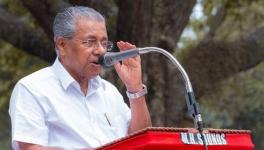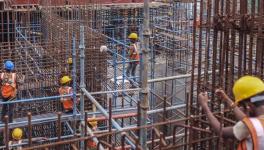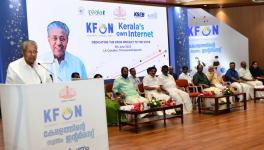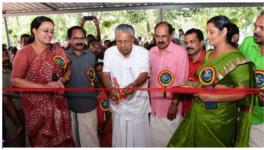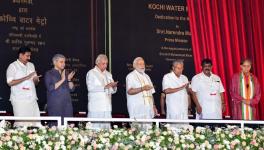Why Kerala Could Tackle Covid-19 While Most Others Struggle
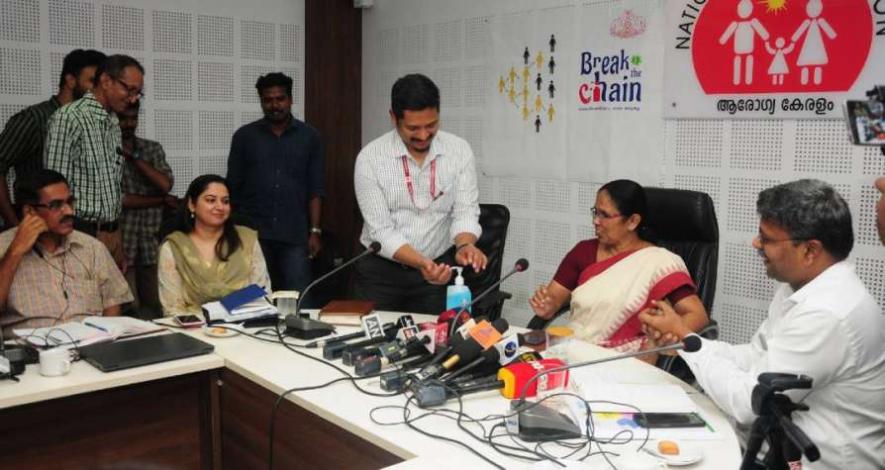
The ongoing global outbreak of Novel Coronavirus or Covid-19 has exposed the incompetence of India’s central government with respect to its ability to manage any disaster, let alone a pandemic of these proportions. There is hardly any available evidence to suggest that the government has been able to plan and execute the testing and tracing of cases and proper quarantine or lockdown across the country.
On Friday, a report pointed out that India has tested some 14,175 people in 72 state-run labs so far, which is one of the lowest testing rates in the world. Despite this grim scenario, Hindutva groups such as the RSS and its associates are presenting a specific kind of solution to ‘cure’ Coronavirus infections: gaumutra, or cow’s urine. To cover the RSS-BJP regime’s failure to deal with this pandemic, these anti-science outfits are organising gaumutra-drinking ‘parties’ and claiming that it will cure Covid-19. However, the so-called head offices, big temples and other religious places of these groups are closed due to the sheer fear of this disease, which exposes the hypocrisy and bigotry that underpins such pseudo-scientific ‘prescriptions’.
After a tedious two-week wait, on 19 March, the Press Information Bureau at the Centre finally notified the probable measures that are to be taken to counter this pandemic. The measures include asking states to take steps to encourage work-from-home at private offices. The government is also scaling down attendance in some categories of public employment by 50%.
Still, conspiracy theories and number counts of Coronavirus-affected patients are ruling the roost in India, while one critical issue is mostly being overlooked. It is that against the backdrop of this global outbreak, India’s working classes are facing a two-pronged crisis: either losing their livelihood or risking their lives to continue working.
Despite the absence of any real official blueprint to deal with Covid-19, the BJP-led government is running a campaign to put in place “social distancing”. Along with this is a campaign which goes by the catch phrase “break the chain”. These measures are supposed to flatten the curve, that is, slow the spread of the virus. Yet, there is not a single official protocol in place to ensure that either of these can actually happen at the national level.
We know very well that a campaign of social distancing, combined with ‘break-the-chain’, is economically affordable only to the urban upper middle classes. Prescribing isolation without any livelihood safeguard for daily-wage labourers, informal-sector workers, people who are living in slums and ghettoised Dalit colonies, amounts to turning a blind eye to the marginalised sections, particularly the most vulnerable who live in the metropolises.
According to the NSSO’s recent periodic labour force survey (PLFS), 15% of the male workforce in urban India and 13% of the female workforce profess a ‘casual’ work status; which means that they are casually employed, without any written work contracts, and receive wages on a daily or another form of periodic payment. Their per-day wage earnings are as low as Rs 314 and Rs 192, for male and female workers respectively.
The estimated total number of casual workers in urban India is 1.56 crore (PLFS, NSSO) including those who are engaged in casual contracts in public works. Besides, in urban India, 8% of casual workers are above the age of 60, which is the age group most likely to get affected by this virus outbreak. This adds up to roughly 12 lakh workers. For this section, a threat such as the Coronavirus pandemic is therefore two-pronged: a risk to livelihoods and also to life.
Therefore, as of now, two weeks of social distancing or isolation—even if we use the most politically-correct terminology of ‘self-quarantine’—would mean that these workers would lose the opportunity to earn their livelihoods for at least 10 working days.
With the growing contractualisation of the Indian workforce, the informal/casual workers has become the biggest section of India’s working class. It is they who are exposed the most to both these risks—livelihood loss and life risk—from the Coronavirus outbreak. Even though the central government is trying to secure facilities for testing and treating infected patients, the potential threat to the working class is not being looked into, and it is certainly not being prioritised.
In this context, the ‘Kerala model’ of dealing with Covid-19 (or any disaster of this scale) is being appreciated for its tremendous performance. In just the last two years, Kerala’s health and disaster-management structures have successfully dealt with the Nipah outbreak and a calamitous flood situation.
Whereas, in most of India, society is considered nothing but a collection of individual customers who are to be herded into private healthcare facilities, Kerala has, for long, recognised healthcare as a critical social responsibility of the State. That is why, by design, preventing epidemics and protecting society from disasters is a part of the overall social-political concerns in Kerala. This is simply not true for most other states of India. Put another way, it is no accident that Kerala has allotted a Rs 20,000 crore fund to tackle the ongoing epidemic, along with a health package, loan assistance, welfare pensions, MG-NREGS work and food grains.
These are not isolated or knee-jerk measures but emanate from the firm resistance that Kerala has offered to this pandemic. The state authorities approached the crisis with a clear plan. It did so in terms of testing and tracing the virus-affected, but, more importantly, by making sure that the marginalised sections do not lose their economic moorings. This is a part of how Kerala was able to ‘break-the-chain’, as part of a mass awareness campaign that it launched earlier this month.
Thus, in Kerala’s context, fighting this virus is not just about social isolation but about washing hands regularly, or sanitising, and spreading the message about why it is necessary. The chain being broken here is of the transmission of this virus through hand-contact, something that experts have repeatedly said, should be done. But without the emphasis on livelihood support this campaign would likely not have worked even in Kerala. It is by adopting economic measures that the state could actually put in place a measure of ‘social distancing’ and ‘break the chain’.
It is a proven fact that private healthcare fails to deal with epidemics. If private healthcare is relied upon during such a crisis, the poorest, in particular, suffer the most. Spain recently renationalised its private hospitals as it attempted to rescue healthcare for the sake of society as a whole, especially its underprivileged.
It is important to note that Kerala has built its healthcare structure over a long period of time. One can say that its people have earned their healthcare services, for they have defended long-term development planning in the face of neo-liberalism’s quick fixes. For instance, Kerala has a functioning rural and urban healthcare infrastructure and yet, on average, it has still allocated 5.6% of its annual budget on public healthcare. Given this context, even if other Indian states decide to perform like Kerala on the Coronavirus front, they would not have the healthcare infrastructure, staff, services or facilities to be able to do so. Note that Kerala has reported 25 positive cases and home quarantined 17,743 so far. Besides, around 18,472 people are under surveillance, of which 268 are undergoing hospital treatment.
As the panic-stricken country reeled in uncertainty and confronted a rising number of infections, on the evening of 19 March, the Prime Minister engaged in a balcony-address-style monologue filled with rhetoric and showmanship. He pronounced a symbolic one-day #JantaCurfew, which has become the talk of the town. He also made a polite request that employers should sanction work-from-home and not cut the wages of absent employees. The question arises, does India now equate a verbal request with a clear official directive or order from the central government. The Centre is in fact evading its responsibility to secure the livelihood of millions of people. It is behaving like a bystander to its own ‘social distancing’ proposals—neither implementing them nor supporting them economically.
India has to ensure a state-led model to get out of this health emergency and restore faith in public healthcare. This is not the time to displace blame between the Center and state. Appeals for social distancing have limited meaning without focusing on sanitary methods of avoiding spread of the infection. Washing hands, not touching the face, or possibly contaminated surfaces, staying away from those who display symptoms that could be Novel Coronavirus, and so on, are some of the essential steps to avoid this infection, which remained un-mentioned in the PM’s address.
In addition, government bodies must ensure a basic income to those who are being expected to spend days on end without work or earnings. Minimum wages, free rations and other basic amenities during this quarantine, most importantly for casual-informal workers, are pre-requisites. Nostalgic quotes from the social distancing experiences of 1918 are a farce without these economic measures.
Breaking the chain to stop Coronavirus from spreading should actually be a call to address the dire situation of healthcare that supposedly caters to India’s working poor and marginalised sections. In the near future, people must raise a cry for healthcare-for-all and a meaningful public policy to respond to future disasters.
Soham Bhattacharya is senior research fellow at the Indian Statistical Institute and Mrityunjay Pandey is research scholar at the University of Hyderabad. The views are personal.
Get the latest reports & analysis with people's perspective on Protests, movements & deep analytical videos, discussions of the current affairs in your Telegram app. Subscribe to NewsClick's Telegram channel & get Real-Time updates on stories, as they get published on our website.









